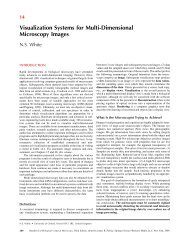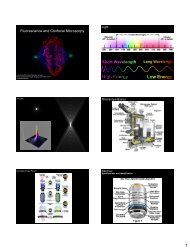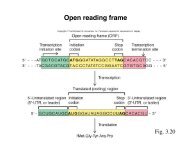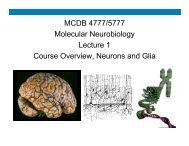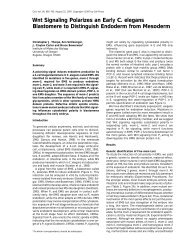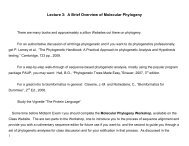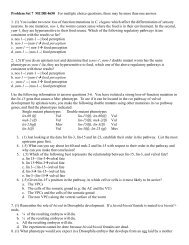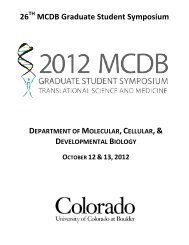Syllabus MCDB 3135 (2012F) - MCD Biology
Syllabus MCDB 3135 (2012F) - MCD Biology
Syllabus MCDB 3135 (2012F) - MCD Biology
You also want an ePaper? Increase the reach of your titles
YUMPU automatically turns print PDFs into web optimized ePapers that Google loves.
<strong><strong>MCD</strong>B</strong> <strong>3135</strong> – Molecular Cell <strong>Biology</strong> I<br />
Fall 2012 <strong>Syllabus</strong><br />
Professor: Greg Odorizzi, odorizzi@colorado.edu, 303-735-0179<br />
Office hours: Tuesday 12:00 – 2:00 PM, Room A420C <strong>MCD</strong> <strong>Biology</strong>, or by appointment<br />
Lab Coordinator: Joy Power, Joy.Power@colorado.edu, 303-735-2723<br />
Teaching Assistants: Kati Buchtel, Christine Crotzer, Roni Denglar, Eli Gendron, April Griffin<br />
Course web site: learn.colorado.edu<br />
Lecture hours: Tuesdays & Thursdays, 9:30 – 10:45 AM in HUMN 1B50<br />
Important dates:<br />
Wednesday, September 12 (5:00 PM): deadline to drop the course without penalty<br />
Thursday, September 20, 2011: Midterm Exam I (9:30 – 10:45 AM in HUMN 1B50)<br />
Wednesday, October 10 (5:00 PM): deadline to drop the course without petitioning the dean<br />
Thursday, October 18, 2011: Midterm Exam II (9:30 – 10:45 AM in HUMN 1B50)<br />
Thursday, November 15, 2011: Midterm Exam III (9:30 – 10:45 AM in HUMN 1B50)<br />
Monday, December 17, 2011: Final Exam (7:30 – 10:00 PM in HUMN 1B50)<br />
Course requisites: <strong><strong>MCD</strong>B</strong> 2150 or EBIO 2070 (prerequisite); CHEM 1133 (pre-requisite or corequisite);<br />
<strong><strong>MCD</strong>B</strong> 3140 is recommended with either <strong><strong>MCD</strong>B</strong> <strong>3135</strong> or <strong><strong>MCD</strong>B</strong> 3145.<br />
Course description: examines the central dogma of biology by discussing DNA, RNA, and<br />
protein, and how their synthesis (DNA replication, transcription, RNA processing, and translation)<br />
is regulated. Incorporated into the discussion is how recombinant DNA techniques are used to<br />
discover and dissect cellular processes, how to design and interpret experiments, and<br />
understanding the limits of experiments to draw conclusions. These principles are the foundation<br />
for subsequent examination of intracellular mechanisms in <strong><strong>MCD</strong>B</strong> 3145.<br />
Learning objectives: After taking this class, you should know the key concepts of the central<br />
dogma of molecular biology, including the composition of genomes and the basic mechanisms of<br />
replication, transcription, RNA processing, translation and RNA turnover, and how the complexes<br />
that perform these activities identify their targets, carry out their function and can be regulated to<br />
meet cellular needs. In addition, you should have a basic understanding of the experimental<br />
approaches and deductions that have shaped, and continues to shape, our understanding of these<br />
concepts. Doing well in this class requires solid prior understanding of genetics, biochemistry<br />
and organic chemistry. For more details about the learning objectives, see the ‘Learning Goals’<br />
below.
<strong><strong>MCD</strong>B</strong> <strong>3135</strong> – Molecular Cell <strong>Biology</strong> I! Fall 2012 <strong>Syllabus</strong><br />
COURSE STRUCTURE<br />
Textbook: The recommended textbook for this course is Molecular <strong>Biology</strong> by Cox et al., 1 st<br />
edition (2012), Freeman Publishing, ISBN-13: 978-0-7167-7998-8. Copies of this text are on<br />
reserve at Norlin library.<br />
Lectures: The lectures will follow the general order of the central dogma of biology<br />
(DNA→RNA→Protein). We will, therefore, first discuss the composition and structure of DNA,<br />
the composition of genomes, the use of recombinant DNA in research, DNA replication and<br />
repair, transcription, RNA processing, mRNA translation, and regulation of gene expression. Key<br />
experiments and deductions that underlie the understanding of the different processes will be<br />
discussed.<br />
A pdf of the lecture slides will be provided on the course website preceding each lecture. The<br />
slides comprise a skeletal record of what happens in the lecture. However, you may find the<br />
lecture slides unintelligible without your own written notes. Therefore, do not think of them as a<br />
second, independent “book” you can read but instead as a collaborative record of the lecture that<br />
you will create.<br />
Clickers: To obtain extra credit, you will need an i-clicker (not a different system such as H-ITT<br />
or PRS). See http://oit.colorado.edu/cuclickers-faq/general-questions/where-can-iclicker-remotesbe-purchased.<br />
Clickers will be used for rapid feedback to foster interactive learning in a large<br />
classroom setting. Clicker questions will be used during class to make you think about and<br />
discuss with your peers how the newly discussed material fit within the bigger picture of<br />
molecular biology and how experimental observation and experimental design can address<br />
questions in molecular biology. Register your i-clicker ASAP.<br />
COURSE SCHEDULE:<br />
Dates Topic Text<br />
Aug 28 – Sep 18 Genes & Genomes Chapters 6-10<br />
Sep 20 Midterm Exam I<br />
Sep 25 – Oct 16 DNA Replication and Repair Chapter 11-14<br />
Oct 18 Midterm Exam II<br />
Oct 23 – Nov 13 Transcription and Translation Chapter 15-18<br />
Nov 15 Midterm Exam III<br />
Nov 27 – Dec 13 Regulation of Gene Expression Chapter 19-22<br />
Dec 17 Final Exam<br />
2
<strong><strong>MCD</strong>B</strong> <strong>3135</strong> – Molecular Cell <strong>Biology</strong> I! Fall 2012 <strong>Syllabus</strong><br />
EXAMS and GRADING<br />
Your grade in <strong><strong>MCD</strong>B</strong> <strong>3135</strong> will be derived from your final score calculated as follows:<br />
Midterm Exam I 22.5%<br />
Midterm Exam II 22.5%<br />
Midterm Exam III 22.5%<br />
Final Exam 22.5%<br />
Problem Sets 10%<br />
Total 100%<br />
Midterm Exams: Three midterm exams will be given during class time. Each exam will count<br />
toward your final grade. See the ‘Course Schedule’ for exam dates.<br />
Final Exam: The final exam will focus on the material discussed after Midterm Exam 3.<br />
Weekly Problem Sets: Weekly problem sets will be administered through the course web site; no<br />
new problem set assigned the week of an exam. Failure to complete a problem set will result in a<br />
zero for that set. The average of the ten highest problem set scores will count for 10% of your<br />
final grade. The lowest two problem set scores will be dropped.<br />
Exam policies:<br />
1. The Midterm and Final exams must be completed in ink. Using a pencil on any part of an<br />
exam will void the entire exam’s eligibility for a re-grade (see below).<br />
2. Pens and ID are the only personal items you may have with you during an exam. Any other<br />
items you bring (backpacks, phones turned OFF, etc.) must be placed entirely under your seat and<br />
are subject to being moved at the TAs' and professor's discretion.<br />
3. Requests to reconsider grading must be submitted in writing with your original exam to Joy<br />
Power within one week of the exam return date. Answering any part of an exam in pencil will<br />
void the entire exam’s eligibility for a re-grade. If anything on the exam submitted for regrading is<br />
found to be altered from its original state, it will be considered a breach of the honor code and<br />
will be grounds for failure in the course and additional disciplinary action.<br />
Extra credit: Extra credit will be based on clicker use (regardless of whether you get the answers<br />
right) and on input from Joy Power and TAs. To get credit for the whole semester, register your<br />
clicker at the beginning of the semester. The amount of extra credit awarded is at the discretion<br />
of the professor. Cheating with clickers by having someone other than yourself use your clicker<br />
during class is considered a breach of the honor code and will result in the loss of all clicker<br />
points for the semester for both yourself and the person bringing your clicker, as well as any<br />
additional disciplinary action as indicated by the honor code. Correct clicker use will be<br />
monitored by the professor and TAs during class.<br />
3
<strong><strong>MCD</strong>B</strong> <strong>3135</strong> – Molecular Cell <strong>Biology</strong> I! Fall 2012 <strong>Syllabus</strong><br />
CLASS POLICIES:<br />
Attendance: Attendance in class is optional but strongly encouraged.<br />
Etiquette: Please refrain from doing anything that might distract you or others (eating, reading<br />
newspapers, surfing the web, texting, and engaging in conversations). Please shut off cell<br />
phones. If you must leave class early, please exit with the least amount of disruption.<br />
Academic integrity: Cheating will not be tolerated and will be subjected to disciplinary action as<br />
discussed above under exams and clickers and as indicated by the honor code. All cheating will<br />
be reported to the University. Please review the University honor code: http://<br />
www.colorado.edu/policies/student-honor-code-policy. It is easier to pass this course by putting<br />
the energy into understanding the material rather than cheating.<br />
Letters of recommendation requirements: Acceptance into programs to further your education<br />
can be very competitive. Thus, you should carefully choose letter writers who know you well and<br />
who can honestly state that you achieved one of the top scores in their class and that your<br />
demonstrated enthusiasm, diligence, and hard work makes the writer confident that you will be<br />
an excellent candidate for the school of application. For me to write a letter of recommendation,<br />
you must have done very well in the class, and you must have been an active participant.<br />
Lecturer’s of smaller classes will usually know you much better, and their letters of<br />
recommendation will, therefore, usually carry much more weight.<br />
Disabilities: If you qualify for accommodations because of a disability, please submit to me a<br />
letter from Disability Services in a timely manner so that your needs may be addressed.<br />
Disability Services determines accommodations based on documented disabilities. Please see<br />
guidelines at: http://www.colorado.edu/disabilityservices/.<br />
Responsibilities: In a class of 200 or more students, it is impossible to teach directly to<br />
everyone’s needs. It is my (and the TAs) responsibility to come to class well prepared and to<br />
provide students with multiple pathways to learning the topics. It is your responsibility to make a<br />
significant effort by reading the text and coming to class prepared for the material.<br />
TIPS ON HOW TO DO WELL:<br />
The most important point is to keep up. The pace is unrelenting because the field of molecular<br />
biology is a rapidly expanding due to intense research. The following practices will help:<br />
1. Print out slides before each lecture.<br />
2. Take good notes during lectures.<br />
3. Actively participate in clicker questions.<br />
4. Read the textbook before and after class.<br />
Your grade will be decided entirely from your final score, not on how you do compared to other<br />
students, so it will never hurt you to help fellow students. In fact, research on learning has shown<br />
that whether you are on top of the material or are having a hard time understanding the concepts,<br />
you will improve your learning by discussing the material with other students. Memorizing slides<br />
and texts is not an efficient method of learning. While some memorization is required to become<br />
literate in molecular biology, the primary goal of the course, and what you will be tested on, is<br />
understanding the key concepts of molecular biology and how to interpret simple experimental<br />
observations.<br />
4
<strong><strong>MCD</strong>B</strong> <strong>3135</strong> – Molecular Cell <strong>Biology</strong> I! Fall 2012 <strong>Syllabus</strong><br />
LEARNING GOALS FOR <strong><strong>MCD</strong>B</strong> <strong>3135</strong>:<br />
After completing this course, students should be able to:<br />
1. Compare the structures of DNA and RNA.<br />
a) Describe how the building blocks of DNA and RNA are similar and how they are different.<br />
b) Describe the 3-D structure of DNA.<br />
c) Describe the nature of DNA supercoiling, its advantages/disadvantages, and how it is relieved.<br />
d) Describe denaturation and renaturation of double-stranded nucleic acids, methods to measure<br />
the degree of double-strandedness, and practical applications of these techniques.<br />
e) Describe how dideoxynucleotides are used to determine DNA sequences.<br />
f) Explain the difference between a gene and a genome.<br />
g) Describe the mechanistic basis for gene duplication and gene transposition and the role both<br />
have in evolution.<br />
2. Describe techniques for manipulating and characterizing cloned DNA.<br />
a) Describe the role of restriction endonucleases in gene cloning.<br />
b) Explain the procedures by which DNA fragments can be ligated into plasmid vectors,<br />
introduced into recipient cells, and their presence selected in the cell population.<br />
c) Describe the key elements required for a plasmid to be useful as a cloning vector.<br />
d) Describe how PCR works and how it can used to generate enough starting material for<br />
cloning.<br />
e) Describe how DNA sequencing works and its practical applications.<br />
f) Compare the procedures for making clone libraries from genomic DNA versus cDNA as<br />
starting material, and cite examples where each would be useful.<br />
g) Explain how to screen clones and/or entire libraries for a DNA segment of interest.<br />
h) Compare the methods for determining gene function in vitro and in vivo.<br />
i) Compare different types of cloning vectors in terms of their applications for cDNA versus<br />
genomic DNA cloning and for production of proteins.<br />
3. Explain the process of DNA replication.<br />
a) Interpret results of the experiments that distinguished proposed models of DNA replication.<br />
b) Explain the semidiscontinuous nature of DNA replication.<br />
c) Explain the utility of temperature-sensitive mutations in the study of DNA replication.<br />
d) Compare the events of replication on the leading and lagging strands (the trombone model).<br />
e) Explain the processivity of DNA polymerase III.<br />
f) Compare the events that occur at replication origins during the initiation of DNA synthesis in<br />
bacteria and eukaryotes.<br />
g) Describe the properties of a DNA molecule that allow it to serve as a template for replication.<br />
h) Describe the roles of DNA helicase, SSBs, the β clamp, DNA gyrase, and DNA ligase.<br />
i) Describe how termination of replication in bacteria differ.<br />
j) Explain the importance of telomeres with respect to germ cells and cancer.<br />
k) Describe the factors that contribute to the high fidelity of DNA replication.<br />
l) Contrast the events of nucleotide excision repair and base excision repair.<br />
m) Explain how parental and newly synthesized strands are distinguished in mismatch repair.<br />
5
<strong><strong>MCD</strong>B</strong> <strong>3135</strong> – Molecular Cell <strong>Biology</strong> I! Fall 2012 <strong>Syllabus</strong><br />
4. Describe the key steps in transcription and translation.<br />
a) Explain the role of a promoter in transcription.<br />
b) Describe the steps during initiation of transcription in bacteria versus eukaryotes.<br />
c) Explain the relationship between a pre-RNA and a mature RNA.<br />
d) Describe the differences in transcription of rRNAs, tRNAs, and mRNAs and explain their<br />
functional relationship.<br />
e) Diagram the structure of a typical eukaryotic gene, showing locations of the transcriptional<br />
start site, 5’-untranslated region (UTR), exons, introns, donor and acceptor splice sites,<br />
translational start site, translational stop site, 3’UTR, and poly-A addition sequence.<br />
f) Explain the steps in processing of an hnRNP into a mature mRNA, and describe the role of<br />
snRNAs and the spliceosome.<br />
g) Describe the triplet nature of the genetic code and how the identities of individual codons<br />
were established.<br />
h) Distinguish between synonymous and nonsynonymous mutations in the genetic code.<br />
i) Explain how tRNAs function as adaptor molecules.<br />
j) Compare the initiation of translation versus elongation.<br />
k) Explain how the effect of a nonsense mutation differs from that of a frameshift mutation.<br />
l) Explain how polysome formation differs in bacteria versus eukaryotes.<br />
m) Explain how bacterial translation is inhibited by certain antibiotics.<br />
5. Describe how gene expression is regulated.<br />
a) Describe the relationship between histones and and DNA in a nucleosome core particle.<br />
b) Explain how nucleosomes are organized into higher levels of chromatin.<br />
c) Describe the structural and functional difference between heterochromatin and euchromatin.<br />
d) Describe the histone code and explain how it determines the state of a chromatin region.<br />
e) Diagram a typical bacterial operon.<br />
f) Describe the mechanistic nature of inducible and repressible operons in bacteria.<br />
g) Describe the mechanistic function riboswitches.<br />
h) Explain the difference between a transcriptional activators and a transcriptional repressor;<br />
between a coactivator and a corepressor.<br />
i) Explain the difference between a general transcription factor and a gene-specific transcription<br />
factor.<br />
j) Describe how the domain structure of transcription factors relate to their function.<br />
k) Describe mechanisms by which transcription factors are converted between active and<br />
inactive forms.<br />
l) Explain the concept of epigenetics in the control of gene expression.<br />
m) Describe how alternative splicing can effectively increase the number of genes in the genome.<br />
n) Describe 3 different mechanisms of translational-level control of gene expression.<br />
o) Describe ways in which mRNA stability is maintained or destroyed.<br />
p) Describe how ubiquitination causes proteins to be unstable.<br />
6




